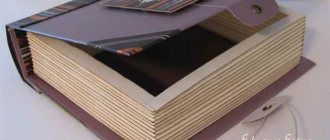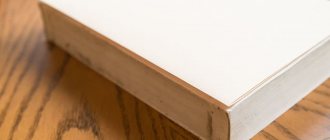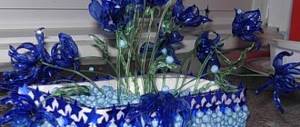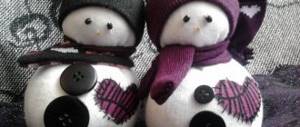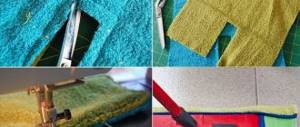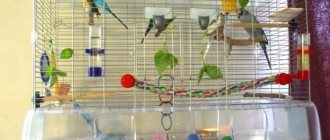03/03/2020 6,299 Hamsters
Author: Olga
Hamsters can be called excellent pets. They are equally suitable for children and adults. However, quite often owners simply do not understand the needs of animals. Animals can be called territorial. They love to dig in the ground and bury themselves in something. Hamsters are constantly active and energetic. And you should understand that it is very important that the pet has its own home. Creating a home for a hamster with your own hands is not as difficult as it might seem.
[Hide]
How to set up a hamster cage?
Important criteria when choosing a building material for creating a cage in which a hamster will live are strength and safety. The size of housing is not so important for these cuties, however, large cages allow you to place all kinds of accessories for games and fun that will appeal to pets and their owners.
Cage made from plastic boxes or bottles
Capacious plastic containers, after minor modifications, become ideal for housing pets. A smaller box is suitable for a Djungarian hamster, a slightly larger one is suitable for a Syrian hamster.
The disadvantage of the design is the lack of ventilation, which can be corrected by making inserts of fine lattice in the sides and roof of the future house. The advantage of plastic: it can be freely cut with a knife or scissors, pierced with a heated awl to create holes for self-tapping screws.
Important! The sharp ends of self-tapping screws or screws should be directed outward to avoid injury to animals.
If two containers are placed one above the other, you can save on space for a second pet or equip a single animal with a second floor. In the latter case, the boxes are combined using a tunnel or ladder. Hamsters love transitions and loopholes.
The simplest tunnel can be easily made from a pair of ordinary plastic bottles, cutting them off on both sides and wrapping the sections with electrical tape. All that remains is to connect the containers together and secure them. Some owners prefer to make transitions from corrugated or sewer pipes.
For some time, a hamster can live in a house made of three six-liter plastic bottles. The upper part is cut off from them, which needs to be reduced so that a funnel with threads and a lid remains. The dishes are arranged in the form of a triangle or one on top of the other vertically. So that the animal can use all the rooms, holes are cut in the lower part of the bottles according to the size of the neck, into which blanks are inserted, playing the role of mini-tunnels.
Important! Cages made from plastic boxes or bottles can be supplemented with appropriate links and expand the living space of hamsters to reasonable limits.
Metal cage for hamster
Aquarium cage from the store
An aquarium or terrarium, as a home for a rodent, has certain advantages:
- excellent review;
- retention of odors inside the container.
- high humidity;
- fragile design;
- difficulty in attaching accessories;
- heavy weight.
In most cases, owners cover the finished glass box with mesh. In the case of a low aquarium, it is metal; for a high capacity, the mesh material is not important. The cold bottom is lined with a thick layer of sawdust. As an option, use a plexiglass box, which is much warmer and lighter. On the other hand, it is cloudy and prone to scratches.
Interior and exterior design
Arranging a cage for an animal involves equipping it with various accessories. This includes a hammock, a running wheel, tunnels, a house, a drinking bowl, and a feeding trough.
- Wheel. Running in circles will satisfy your hamster's need for movement. The diameter is determined by the size of the animal. A twenty-centimeter design is enough for Djungarians; wheels with a diameter of 30 cm are suitable for Syrians. As they grow older, the device is replaced with another one in accordance with the growth of the animal.
Wooden cage for hamster
Important! Choose a solid treadmill; the grid can injure your paws.
- Tunnel. Helps maintain an active lifestyle. It is also selected according to the size of the pet. The main condition: so that the hamster does not get stuck.
- Hammock. Plastic or metal rocking chairs are responsible for the development of coordination of movements.
- Drinking bowl . The animal must be provided daily with clean drinking water poured into a nipple drinker or bowl.
- Feeder. It is not necessary to acquire a special container that is difficult to turn over; food can be scattered throughout the cage. It is useful for a hamster, especially the Djungarian breed, to hone its instinct to search for food.
- Litter. As a rule, dense, odorless wood pellets or large pressed sawdust, with the exception of cedar and pine, are poured onto the bottom of the cage. Such sawdust can cause allergic reactions or bronchospasm. An alternative option is finely chopped ears of corn, which the animals love to burrow into. Mineral litters are toxic to rodents, and cat litters should not contain clay. The minimum depth of litter is 6 centimeters.
- Nesting material. To set up a nest, hamsters are allowed to offer unscented toilet paper, paper napkins or towels torn into pieces.
Toys such as toilet paper rolls or cardboard boxes will occupy the hamster's attention for a long time until he chews them. Mineral stones are used to grind teeth.
Important! When the air temperature in the room is high, it is advisable to place a piece of ceramic tile or tile with ground edges in the cage. These objects remain cool even in the heat and the animals will be able to cool themselves by lying on them.
Walks
The hamster should be periodically given the opportunity to roam. For these purposes, special clothing must be purchased. You can also buy additional accessories. It’s worth understanding what a harness and a walking ball are.
Walking ball
Non-toxic plastic is used to produce the balls. It may vary in color. The ball has holes for paws and ventilation. Hamsters will be able to get used to such an accessory quite quickly. They will first need time to figure out what the system is. After some time, the hamsters will begin to roll around in circles. They will need a little more time to learn how to control the ball.
It should be noted that a harness is not as secure as a ball. In it, the pet will not be able to climb into any gap, from which it will then have to be taken out. However, predators will be able to cut through the plastic with their sharp claws and injure your pet. Therefore, it is not recommended to leave him alone.
Using a leash
Special clothing for walking and a harness may be purchased. It is a simple leash. The harness clings either to clothing or directly to the pet. In this form you can walk with a small animal. A leash ensures that the animal cannot hide behind cabinets.
However, clothing and harnesses require certain skills. Putting them on your hamster is not as easy as it might seem. You need to hook the leash so that it covers the neck and chest. The harness should not press too hard.
Naturally, as a dog, even a harness will not allow you to walk your hamster. He will lead you during walks. You are required to ensure that your pet does not get entangled or suffocate. Therefore, constantly check whether the harness has begun to squeeze the neck.
How to make a house with your own hands?
Making your own house for a pet helps to unite the family. The most common materials for construction:
- Coconut shell. Dwarf hamsters will appreciate your efforts when they receive an original coconut shell house for use. The Dzungarians will be happy to hide in it and relax.
Plastic cage for hamster
Rules for peeling the insides of a nut:
- open the eyes of the coconut and drain the milk through them;
- tap next to the eyes with the blunt side of a knife or a chop mallet and when a crack appears, remove part of the shell using a knife or hacksaw;
- place the fruit in the freezer for half an hour, which will make it easier to separate the pulp;
- remove sharp corners and burrs, sand the edges of the hole.
- Lego. An unnecessary children's construction set will serve as a wonderful building material for a pet's home. The number and type of Lego parts will determine whether you will have to limit yourself to a modest house or whether you will be able to build a real castle. It may be possible to build a fence, fence off a playground and build a staircase.
Important! Gluing the joints will help achieve maximum strength.
- Cardboard box. Miniature animals will willingly use houses that are made for them from used packaging. Even a small owner can cut out an entrance in a cardboard container. Ventilation holes are also welcome. If you have a tissue box with a ready-made hole, just cut it into two halves. You can use a toilet paper roll at the entrance as a corridor. The disadvantage of a cardboard house is its fragility.
- Parcel box. It is not particularly durable, but such containers can only be slightly modified, and plywood can be easily adjusted. All you need to do is drill an entrance on the side of the box, windows and paint the house - if desired.
Important! You can paint an animal’s home only with non-toxic paints: watercolor or gouache.
- Stand for toothbrushes. The oval object is laid on its side and fixed. Other available materials can also serve as suitable materials for equipping a dwarf hamster’s house: bowls, basins, jars for bulk products, food containers, plastic bottles, flower pots.
- Plastic containers for cereals. It happens that a hole in cans of this type is already provided. If the lid is solid, you can simply cut it in half to provide your pet with passage inside. The round jar should be secured.
- Glass jar. Durable and easy to clean dishes that are sure to please owners. But not all pets are optimistic about transparent shelters, preferring to hide in a secluded place. The situation is corrected by painting or gluing the jar, which then must be attached to the walls of the cage with wire. Before pouring the bedding, the slippery surface of the bottom is smeared with glue and sprinkled with sand.
- Branches. Suitable for creating a kind of cave. The cardboard strip is glued to the floor with short sides like an arched roof, which is glued on top with pieces of thick branches and blocks. The back wall can be made of cardboard or sewn up with branches. The second option: the base of the house is made of a ready-made box or a home-made frame, which is then covered with twigs on top.
- Popsicle sticks. This idea of building a hut for everyone’s favorite will be more useful to city dwellers, since in city conditions it is difficult to collect a sufficient number of even branches. First, each detail of the house is drawn on cardboard and cut out with scissors. Then, the elements of the hut are fixed to each other using tape and the blank is glued on the outside with ice cream sticks.
- Wooden boards and plywood. Using the previous sketch, you can build a wooden house with a flat or gable roof. This time, the parts are cut out of a board or sheet of plywood and attached to a frame made of wooden blocks with nails or self-tapping screws. If the roof is removable, this will greatly facilitate the cleaning process.
How and from what to make a house for a hamster with your own hands?
join the discussion
Share with your friends
When purchasing a hamster, in any case, you will also have to think about a home for it - an ordinary cage or a full-fledged house. The second, by the way, can be made independently and thereby get a multifunctional design, spending a minimum of money. There are also variations of small houses that are simply placed inside the cage and are used more for play.
Design Features
A home made for a hamster, made with your own hands, must have several mandatory areas: where the rodent will sleep, eat and store supplies. In addition, it is important not to ignore the toilet, bedding, the opportunity to play and carry out hygiene procedures. For toys, experts recommend purchasing a running wheel, the size of which depends on the size of the animal, well-ventilated tunnels, hammocks or swings, as well as parts that allow you to develop teeth: wooden sticks, twigs, mineral stones.
For drinking, you will need a drinking bowl, which will do just fine in a regular bowl. For food, you should take a couple of containers - for wet and dry options. We must not forget about pressed sawdust.
Dimensions
Of course, the size of a home-made house is determined depending on the size of the rodent itself, and what functions the structure should perform. Alternatively, a wooden house for a small hamster requires side walls measuring 10 by 10 centimeters, and the front and back must be at least 15 by 10 centimeters. For the top, take a piece of wood with sides 17x12 centimeters.
Form
In principle, the shape of the house under construction can be anything. However, there are several requirements for the design itself:
- it is important that the owner has the opportunity to get inside and clean;
- in the building for small hamsters there should not be large cracks through which they can escape;
- if the rodent, on the contrary, is large, it may get stuck in a passage that is too narrow, so these should also be avoided.
What should the tunnels be like?
Whether you buy ready-made hamster tunnels or create them yourself, it is important to take a few details into account.
The structure should not have too high (steep) descents or ascents, otherwise the animal has every chance of getting injured.
The tunnel must have space and ventilation. This is necessary in case your pet starts playing and stays in the tunnel for a long time. Entertainment should not be accompanied by inconvenience and discomfort. And even more so, the hamster should not suffocate during its journey. Air holes must be made before presenting the toy to the hamster.
It is important to control that the animal does not chew on the structural elements, regardless of whether they are cardboard or plastic - the attraction must be beneficial. At the end of any maze (and, if possible, at different stages of the hamster’s path), you must put a treat for the little tracker.
The animal’s house should not contain a pile of numerous tunnel pipes. The pet needs a spacious room. It is important to provide him with this, without forcing him to huddle in the corner of the cage. The pet should feel love and care - this will evoke reciprocal feelings in him and prolong his life.
And the last thing concerns homemade structures. Glue should be used only non-toxic types, without odor and fumes. In addition, there should be no glue particles left inside the tunnel. This substance is harmful to the hamster, so it must be removed from the inner surface before the animal gets there.
Step-by-step instruction
Having decided to assemble a house for a hamster at home, it is important to make sure that the selected material is environmentally friendly, and if the animal tries it “to the teeth”, there will be no horrifying consequences for its health.
If plastic is used for construction, it must be food grade.
From cardboard
It’s easy and simple to make a cardboard house, but it won’t be particularly durable and durable. You can print the template on thin paper, and then transfer it to cardboard and cut it out with a stationery knife. Then all the parts are bent in the required places and glued together. At the last stage, an entrance hole for the rodent is cut.
However, it is much easier to take a cardboard box left over from paper napkins and construct a home based on it.
From plastic bottles
To create a plastic structure, you will need a one and a half liter bottle, a stationery knife, a marker, scissors and a lighter, which, if not available, can be easily replaced with matches. The required height of the house is measured from the bottom of the container and marked with a marker with a solid line around the entire circumference. Using a stationery knife, this part is cut off, and the edges are melted under the influence of a lighter.
Next, a passage in the shape of an arch is cut out in the house, the edges of which are also treated with fire.
If you ignore this step, the animal may be injured on a sharp surface. The finished house is placed inside the cage.
There is a variation of making a more complex design from three or four five-liter bottles. Its drawing is best studied on the Internet, but the main idea of the design is that the bottles are connected, inserted into one another, forming tunnels. In one of the containers a bedroom is made, in the second the feeding process is organized, in the third the hamster can go to the toilet, and in the fourth, if there is one, he can have fun on the wheel. The components of the house are further strengthened with each other using glue and tape.
Another plastic home for a rodent is a structure made from an ordinary container in which useful little things are stored. The size of the box used should be quite large so that the hamster does not experience any discomfort while being inside. For example, it could be a container measuring 640x460x300 millimeters.
A felt-tip pen and ruler, construction mesh, pencil and knife, lighter or matches, as well as plastic clamps are also useful for making. A hole is cut in the lid using a heated knife blade, which is then tightened with a mesh secured with clamps. The holes for the latter are again created with a hot knife.
From plywood
Having obtained a ready-made parcel box made of plywood, you can transform it into a house for a hamster. An inlet hole is drilled or cut on the side of the structure. If desired, you can cut through several windows. Such a house should be painted with colorless paint for an attractive appearance.
From coconut
A house made from coconut will be the most environmentally friendly and stylish. The main thing to do is to cut a hole with a diameter of at least 5 centimeters. After draining the milk, you must also remove all the pulp from inside using a chisel.
If you first keep the coconut in the freezer, it will be much easier to clean. The empty coconut is washed well, and the entrance is additionally sanded with sandpaper. Such a house is placed in an animal cage.
From paper
The easiest way to create a home for a hamster is to use two cardboard tubes left over from toilet paper or paper towels. Both are alternately flattened, after which semicircular holes are cut into them on both sides. After straightening, one tube is inserted into the other, forming a cross. This structure is placed in a cage.
Another unusual paper house can be made from toilet paper itself. Although it will likely not last more than a couple of days, making it is so simple and economical that you can create the design as many times as you like to entertain your pet. In addition to toilet paper, a balloon and a basin filled with water will come in handy. First of all, the balloon is inflated to the size of a large apple. Next, the paper is torn into separate pieces and soaked in water.
Each sheet is immediately glued onto the ball. You will have to act until eight layers are formed on the structure and it is completely covered. Then the future house is removed to dry on the radiator. The hardened structure must be removed from the ball, for which it is pierced with a needle or simply untied. At the end, a neat arch-shaped entrance is cut into the hemisphere.
Made of wood
It takes quite a long but interesting time to create a wooden house from ice cream sticks. In addition to 80-120 pieces, wood glue, a ruler and a knife will come in handy. To create a house, a drawing is first drawn up. This structure has two side walls, a floor, a ceiling and two parts of the roof. All of them are created by connecting sticks in parallel. The finished floor, ceiling and walls are glued together.
To make roof rafters, you will need to place sticks lengthwise and then crosswise to ensure greater security. While the glue is not dry, you can further strengthen everything with rubber bands.
If the house is planned to be two-story, then you will need to think through a system for getting to the second level, for example, thanks to a staircase made from the same sticks.
The most successful solution, of course, is a full-fledged wooden house. The wood used must be coated with an antiseptic and stain. If desired, you can also provide a varnish layer, this will simplify the process of cleaning the structure. For construction, you will need a board 4 centimeters thick, ideally from deciduous wood. In addition, a drill, sandpaper, a hammer, a set of nails, wood glue, a jigsaw and a drill will come in handy.
First of all, blanks are prepared according to the drawings. Then holes are cut out for entry and ventilation. For convenient fastening, narrow strips used at connection points are useful. Each detail is worked on with sandpaper, and its edges are smoothed with sandpaper.
Teeth chewing toys
In order for a hamster to feel good, it must receive a lot of plant food. Rough hay is not only good for rodents, but also helps them wear down their teeth. For domestic hamsters that receive excellent nutrition, sometimes it is not enough to chew only hay to wear down their teeth. To prevent excessive growth of incisors in rodents, they need to be given special treats.
Industrial treats are mineral stones, sweet sticks glued together with something like caramel, etc. The problem is that with proper feeding, mineral stones can lead to an excess of trace elements in the hamster's body, and this is deadly. Sweet treats are very high in calories and if consumed constantly, your pet’s health will suffer.
Homemade teeth chewing toys are much safer. As a toy you can use:
- Clean bark of fruit trees.
- Young branches of sea buckthorn, cherry, apricot, apple, birch.
We invite you to familiarize yourself with: FLOWER HORN (Cichlasoma hybr. “Flower Horn”) » Home aquarium
Gnawing toys can be stored for future use. It is advisable to cut the branches in the spring, before the resins begin to move. Immediately after collection, the branches must be washed in warm water and thoroughly dried naturally. It is better to store the collected treats in a cardboard box in a dark and cool place.
Industrial treats are often treated with special solutions and preservatives, which allows them to be stored in cellophane packaging. When storing independently collected twigs in cellophane, mold may appear on them.
Materials for a rodent house
A house, a cage, toys, a running wheel, and a mineral stone cost more than the rodent itself. At home, you can independently arrange a home for the dwarf. Then you will be sure of the proper quality of materials and the compliance of the cottage with the size of its owner. The apartment for a Syrian hamster should be larger than for representatives of other breeds.
If you are wondering what you can make a house out of, pay attention to the following materials:
- Plywood or wood.
- Thick paper, boxes.
- Natural materials (wood, coconut shell).
- Popsicle sticks.
- Plastic.
- Toilet paper rolls.
The main purpose of a cottage for a rodent is to provide it with rest, protect it from prying eyes, sources of loud sounds and pungent odors. To make your rodent’s home convenient and comfortable, follow these recommendations:
- When making a hut with your own hands, take care of the cleanliness of the materials.
- First, make drawings of the cottage. Consider the size of the animal, the height and area of the cage, and the materials used.
- To fasten the parts of the house, use paper clips, wire, and nails. It is undesirable to work with PVA glue for wood, as they can harm the health of the rodent.
- When assembling the hut, make sure that there are no nails or sharp edges of the mesh inside.
Why do rats need shelter?
A trained pet uses the house infrequently. But the shelter should still be in the cage so that the rat can use it at the right time.
Stressful situation
Tame rats are also afraid of strangers and loud noises. They may experience stress when the cage is moved to another location or a new pet appears in the apartment. If the animal does not have the opportunity to hide in order to calm down, it will be nervous and aggressive.
Females often need shelter. By nature they are more restless and timid than males.
Bad feeling
Rodents may feel unwell for no particular reason. For example, when you ate something inappropriate. At such moments, they need to retire to get into the right physical shape. The animal may have a desire to hide when it is offended. Rats with a distrustful nature often hide. They need it physically and psychologically, otherwise they will feel bad.
Paper house for Djungarian hamster
Making a hut from paper and cardboard does not require a lot of money or a lot of time. A paper cottage is a temporary shelter, easy to make and quickly fails.
Materials: toilet paper, inflatable balloon, bowl of water.
Preparation method:
- Blow up a balloon the size of an orange.
- Tear the toilet paper into several pieces and soak in water.
- Glue the wet sheets onto the ball in 8–10 layers.
- Let the structure dry thoroughly.
- Release the air from the balloon by poking it with a pin.
- Remove the deflated ball.
- In the resulting paper sphere, make an entrance for the Djungarian hamster.
Such a fragile home is suitable for small rodents. The cottage of a large individual should be more durable.
Coconut shell hamster housing
A coconut house is stronger than a paper house, but it takes longer to make. Before you start decorating it, drain off the coconut milk.
Materials: coconut, small drill, sandpaper.
Preparation method:
- Make holes with a diameter of 5 cm on both sides of the fruit. One will serve as an entrance for the pet, the other is needed for stability.
- Using the holes, remove the pulp from the coconut.
- Drill 4 holes on the side of the nut. They will perform the function of ventilation.
- Place the house on the cut hole.
- Sand the arch above the entrance.
A coconut apartment is not only beautiful and original, but also useful. The rodent will chew on it, obtaining nutrients and grinding down its teeth.
Ball without fastenings
An ordinary hamster ball will allow your pet to move freely around the house or apartment in any direction. It should be noted that this accessory is also a guarantee of the safety of your pet, even if, for example, a cat decides to attack it, or you accidentally forget that the animal is under your feet. For owners living in a large area, a hamster ball will be the best option for solving the problem of an animal walking.
Wooden hut for a rodent
A wooden cottage turns out to be beautiful, solid, and environmentally friendly. All family members can participate in its creation.
Materials: Hardwood or thick plywood, drill, jigsaw. Sandpaper, nails, hammer or non-toxic glue.
Preparation method:
- Draw up a project for your future house. Make two pieces of wood for the floor and ceiling, and four for the walls.
- Drill a hole in one of the walls for entry.
- Sand all parts including the inlet.
- Drill a couple of holes with a diameter of 2–3 cm in the side walls. Windows will form from them.
- Using nails or glue, assemble all the elements of the house.
- For quick cleaning, leave the sawn roof removable.
A wooden box-shaped house with a removable roof is easy to make. You can make a two-story cottage out of plywood by connecting the floors with a ladder.
Hamster house out of a box
The box apartment is very simple to make; the animal can store its treasures in it. Take a box of suitable size and make an entrance hole in it. You can use tea packaging, paper napkins, or children's shoes. Cut two holes in the rectangular box, one for entry and one for stability.
Make a beautiful and bright shelter for your rodent from cardboard. Print out the house layout on a color printer, cut it out and glue it together. The apartment can be made of any size depending on the size of the pet.

